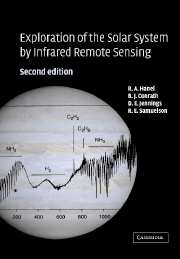Book contents
- Frontmatter
- Contents
- Introduction to first edition
- Introduction to second edition
- 1 Foundation of radiation theory
- 2 Radiative transfer
- 3 Interaction of radiation with matter
- 4 The emerging radiation field
- 5 Instruments to measure the radiation field
- 6 Measured radiation from planetary objects up to Neptune
- 7 Trans-Neptunian objects and asteroids
- 8 Retrieval of physical parameters from measurements
- 9 Interpretation of results
- Closing remarks
- Appendices
- References
- Abbreviations
- Index
7 - Trans-Neptunian objects and asteroids
Published online by Cambridge University Press: 07 September 2009
- Frontmatter
- Contents
- Introduction to first edition
- Introduction to second edition
- 1 Foundation of radiation theory
- 2 Radiative transfer
- 3 Interaction of radiation with matter
- 4 The emerging radiation field
- 5 Instruments to measure the radiation field
- 6 Measured radiation from planetary objects up to Neptune
- 7 Trans-Neptunian objects and asteroids
- 8 Retrieval of physical parameters from measurements
- 9 Interpretation of results
- Closing remarks
- Appendices
- References
- Abbreviations
- Index
Summary
All planets from Mercury to Neptune and most of their satellites have been observed from Earth-based telescopes and at least once, some repeatedly, from spacecraft. Therefore, sufficient information was available to emphasize the physical principles in the discussions in Chapter 6. Trans-Neptunian objects and asteroids have been explored to a much lesser degree. Their small sizes, for many their large heliocentric distances, and their low surface temperatures prevented detailed exploration. Until recently, only a few samples of an enormous amount of objects have been investigated. Therefore, the treatment of these objects, grouped in this chapter, is primarily a summary of presently known properties. Section 7.1 discusses Pluto and its satellite Charon; Section 7.2 is devoted to comets; and Section 7.3 to asteroids.
Pluto and Charon
In 1930, Tombaugh discovered Pluto, the outermost known planet (Reaves, 1997; Marcialis, 1997). Several authors have derived the radius of Pluto with very small uncertainties; unfortunately, the derived values do not overlap. Consequently, only a broad range can be quoted (1145 to 1200 km) within which the true radius of Pluto may fall (Tholen & Buie, 1997). Pluto is by far the smallest planet of our Solar System; it is even smaller than many planetary satellites. Pluto's orbit is highly eccentric and inclined by more than 17° to the ecliptic plane (Malhotra & Williams, 1997). At perihelion (29.7 AU), Pluto is closer to the Sun than Neptune (30.1 AU), and at aphelion it reaches a heliocentric distance of almost 50 AU.
- Type
- Chapter
- Information
- Exploration of the Solar System by Infrared Remote Sensing , pp. 342 - 351Publisher: Cambridge University PressPrint publication year: 2003



